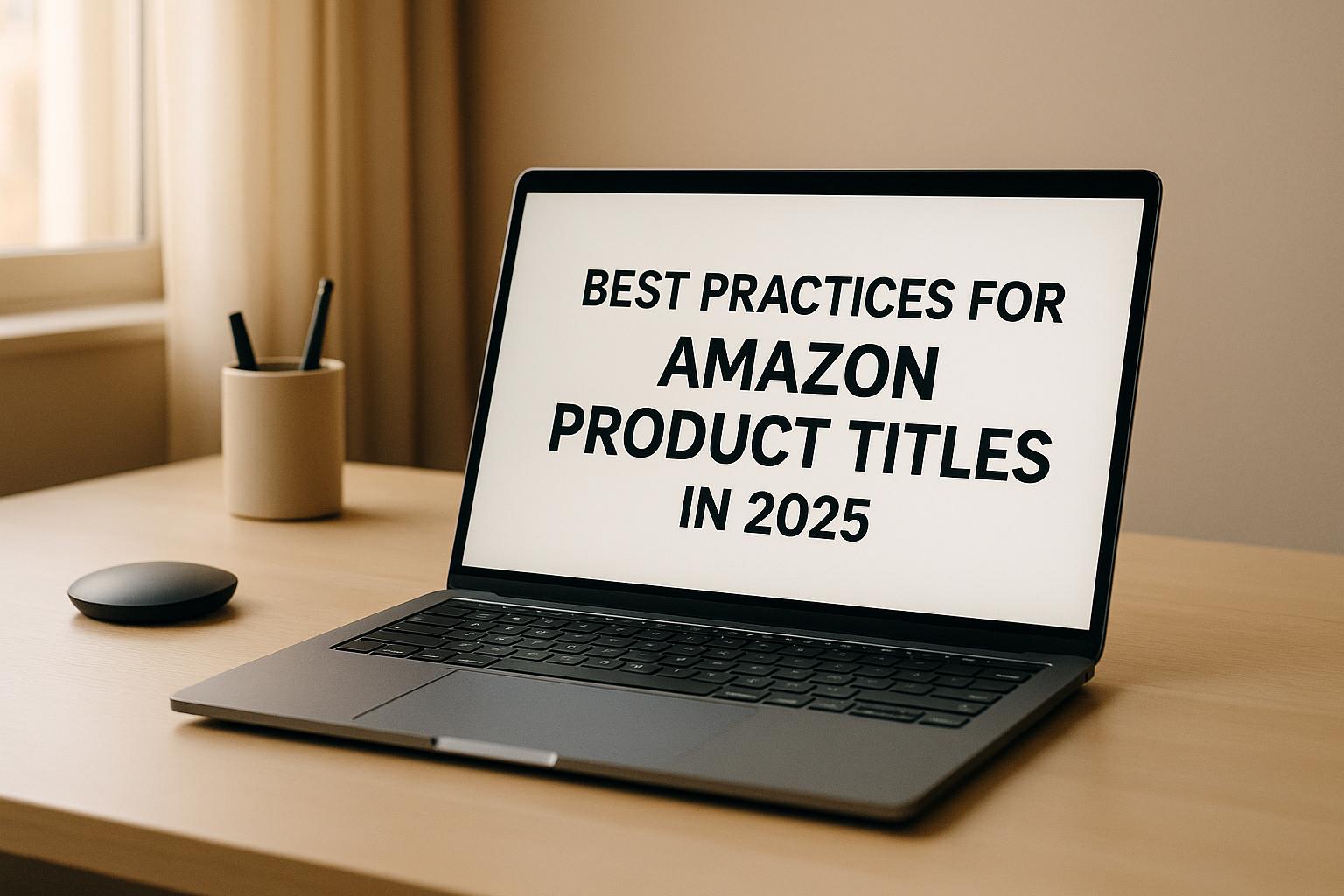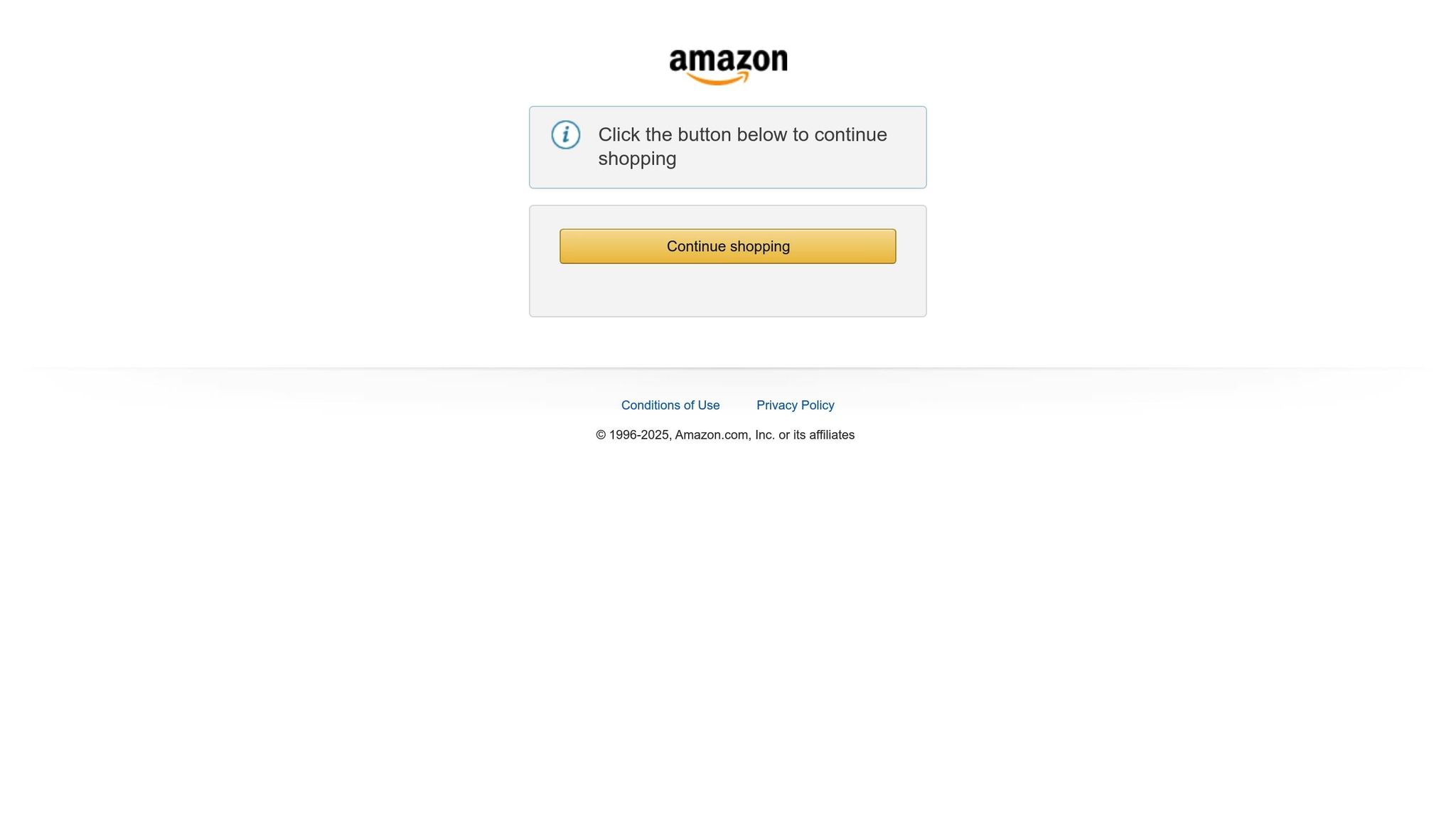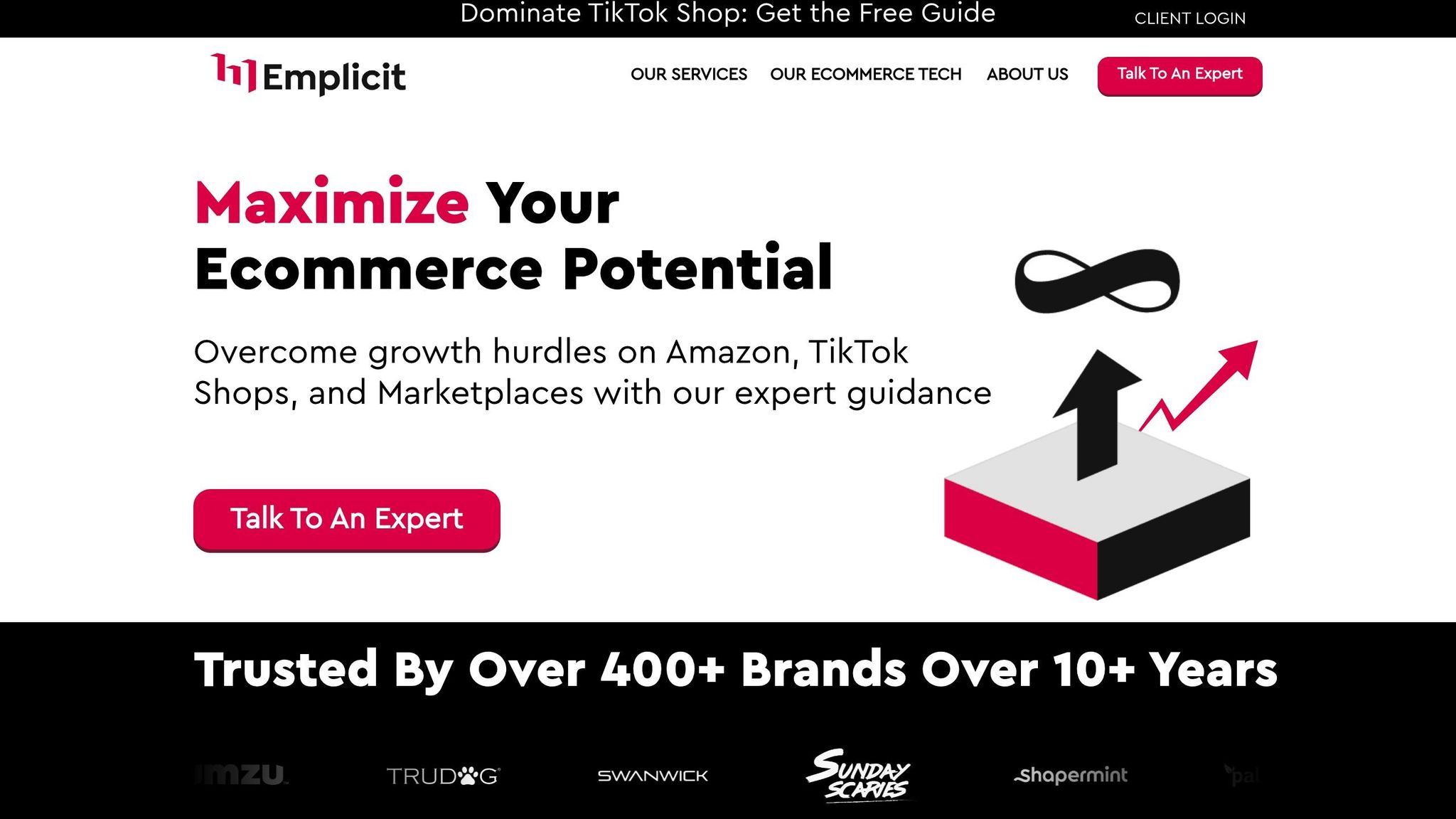
Amazon‘s 2025 updates for product titles focus on clarity and simplicity, making product listings easier for shoppers to understand and improving search rankings. Key changes include:
- Character Limit: Titles must be under 200 characters, though Amazon recommends keeping them between 80–100 for better readability, especially on mobile devices.
- Special Characters: Symbols like
!,?,{}, and^are banned unless part of a brand name. Others like|and;are still allowed. - No Repetition: Non-exempt words can appear only twice in a title, including singular and plural forms. This reduces keyword stuffing.
- No Promotional Phrases: Phrases like "Best Seller" or "Top-Rated" are prohibited.
- Brand Name First: Titles must begin with the brand name and follow proper title case capitalization.
These updates aim to enhance the customer experience by creating concise, professional titles that are easier to read and more effective at converting clicks into sales. Sellers must comply with these rules to avoid penalties like listing suppression or reduced visibility.
Pro Tip: Focus on front-loading essential details (brand, product type, key features) within the first 80 characters for mobile shoppers, who make up over 60% of Amazon’s user base.
Amazon‘s 2025 Product Title Requirements

Title Length and Content Rules
Amazon has introduced updated guidelines for product titles, focusing on three key areas: character limits, special character usage, and word repetition. Sellers need to follow these rules to keep their listings compliant and avoid penalties.
Character Limits: Titles must stay under 200 characters, including spaces.
Special Character Restrictions: Non-brand special characters are now limited. Symbols like !, $, and ? are not allowed unless they are part of the brand name, while symbols such as | and ; are still acceptable. Certain symbols, including ¦ and ¬, are explicitly banned. These restrictions aim to make listings look cleaner and more professional.
Word Repetition Rules: Each non-exempt word can appear only twice in a title, with exceptions for prepositions, articles, and conjunctions. Amazon also treats singular and plural forms as the same, so using both "shoe" and "shoes" would count as a repeat. This rule is designed to prevent keyword stuffing and ensure titles are easy to read.
Additionally, Amazon has banned promotional phrases like "Best Seller", "Top-Rated", "#1 Choice", and "High-Quality." Titles must now begin with the brand name and use proper title case capitalization.
Compliance Timeline and Enforcement
Amazon began enforcing these new title rules on January 21, 2025. Sellers were given a 14-day grace period to fix non-compliant titles using the Review Listing Updates section for brand owners or the Manage All Inventory section for other sellers.
Compliance is monitored through the Listing Quality Dashboard. Non-compliance can lead to listing suppression, lower search rankings, account warnings, or even suspensions. Regularly checking the dashboard is crucial to catch and update any non-compliant titles before receiving a violation notice.
As Amazon frequently adjusts its policies, staying informed is critical. Following these title guidelines not only helps sellers avoid penalties but also creates standardized, clear titles that improve the shopping experience for customers.
Amazon Product Title Best Practices in 2025 | Amazon Seller Must Know
How to Write High-Converting Titles in 2025
With Amazon’s 2025 title requirements in mind, crafting titles that convert requires more than just following a set of rules. You need to strike the perfect balance between keyword optimization and a customer-first approach. Your title should immediately showcase your product’s value while also appealing to search algorithms.
Recommended Title Structure
The best Amazon titles follow a tried-and-true formula that boosts both search rankings and customer interest. A widely recommended structure is: Brand + Product Type + Key Features + Differentiators.
Start with your brand name, then clearly specify the product type using terms that shoppers are most likely to search for. Make sure to include key details – such as size, color, material, or quantity – within the first 80 characters. This is especially important since over half of Amazon shoppers (53%) browse on mobile devices. By placing essential information upfront, you ensure it’s visible even on smaller screens.
Here’s an example of how this structure works for a wireless earbud listing:
"SoundTech Wireless Earbuds – Bluetooth 5.0, 24-Hour Battery Life, Waterproof IPX7 Rating for Sports and Workouts."
This title covers the brand, product type, key features, and a primary use case, all while staying concise.
To maintain professionalism and readability, capitalize major words, use numerals, and spell out measurement units unless Amazon specifies otherwise. This approach aligns with Amazon’s style preferences and helps your title stand out.
Using Keywords Without Overstuffing
Keywords are essential for visibility, but overloading your title with them can backfire. Titles carry more weight for ranking than bullet points or descriptions, so place high-impact keywords at the beginning where they’ll have the most influence on Amazon’s algorithm. Stick to terms that customers naturally use in their searches, avoiding internal jargon or overly technical language.
Using a mix of short-tail and long-tail keywords can help you cover a wide range of search intents. Experiment with different combinations to see what resonates with your audience, but always ensure the title remains logical and customer-focused. A cluttered or unnatural title will confuse shoppers and hurt your chances of conversion.
Common Title Mistakes to Avoid
Some missteps can harm your listing’s performance or even lead to Amazon penalties. Here are key pitfalls to watch out for:
- Avoid promotional phrases, restricted keywords, or special characters that violate Amazon’s updated rules.
- Keep titles concise. Overly long titles often include unnecessary text, making them hard to read on mobile and diluting your message.
- Don’t include pricing, shipping, or condition details. Amazon already handles this information separately.
- Avoid keyword stuffing. Overloading your title with keywords can make it unreadable and may trigger penalties.
"While keywords are essential for ranking, stuffing too many into your title can make it unreadable. Keep your title natural and clear so shoppers instantly understand what your product is." – MyAmazonGuy
Misleading titles are another major issue. If your title doesn’t accurately reflect your product, you risk dissatisfied customers and increased returns. Avoid exaggerated claims about features or performance that your product can’t deliver. Amazon’s algorithm factors in customer satisfaction, so misleading titles can hurt your rankings.
Lastly, steer clear of all caps, emojis, or decorative characters. These not only make your listing look unprofessional but may also violate Amazon’s style guidelines. Stick to proper title case and standard punctuation to maintain credibility.
A clear and well-structured title is your product’s first impression. It’s a critical factor in helping shoppers make confident purchasing decisions and can significantly influence your success in Amazon’s competitive marketplace.
sbb-itb-e2944f4
Pros and Cons of Amazon’s 2025 Title Guidelines
Amazon’s new title requirements for 2025 bring significant changes to how sellers craft their product listings. While these updates aim to create a more streamlined and user-friendly shopping experience, they also require sellers to rethink and adjust their title strategies.
Benefits vs Drawbacks Comparison
| Aspect | Benefits | Drawbacks |
|---|---|---|
| Customer Experience | Clearer titles make it easier for shoppers to identify, compare, and choose products. | Titles that don’t comply with the guidelines may fail to grab attention, potentially reducing click-through rates. |
| Search Visibility | Following the new rules can lead to better conversion rates and improved search rankings. | Listings that violate the guidelines risk suppression, lower visibility, or even account-related issues. |
| Brand Control | Consistent title formatting enhances professionalism and strengthens brand image in Amazon’s marketplace. | Automated adjustments to titles could weaken your brand’s voice and disrupt existing keyword strategies. |
| Keyword Strategy | Concise, well-structured titles can build customer trust and boost conversions when keywords are used strategically. | Strict character limits make it harder to incorporate creative or detailed formatting, requiring careful word selection. |
| Operational Impact | – | Updating titles across large catalogs is time-intensive and may require significant effort. |
| Account Health | Compliant titles contribute to maintaining strong seller metrics and avoiding penalties. | Persistent non-compliance can harm metrics and lead to suppressed listings, which are difficult to resolve unless you own the brand. |
This table highlights the balancing act sellers face as they adapt to the 2025 title guidelines.
The updated rules emphasize clarity, pushing sellers to refine their word choices and title structures. Amazon provides tools like the Review Listing Updates tab in Seller Central to help identify and fix non-compliant titles, underscoring the importance of staying ahead in managing product listings.
For larger sellers, these changes are especially impactful. With third-party sellers growing at 52% annually compared to Amazon’s 25% growth in direct sales, the competition for visibility is fiercer than ever. While standardized formatting ensures consistency, it also limits the creative flair that previously helped listings stand out.
These guidelines mark a shift in title optimization strategies. Instead of packing titles with as many keywords as possible, success now hinges on placing the right keywords in the right spots within tighter constraints. Sellers who adapt effectively and prioritize clarity are more likely to see improved performance, aligning with Amazon’s goal of offering a better shopping experience. Adjusting your approach to these changes is key to thriving under the new rules.
How Emplicit Can Help You Optimize Amazon Titles

With Amazon’s strict 2025 title rules on the horizon, expert guidance has become more important than ever. Considering Amazon accounts for nearly 40% of the US ecommerce market, optimizing your product titles isn’t just about compliance – it’s about staying competitive. This is where Emplicit’s expertise comes into play.
Emplicit’s Amazon Optimization Services
Emplicit specializes in helping brands launch, rebrand, and grow on Amazon. Their approach to title optimization isn’t about cramming in keywords. Instead, they focus on crafting titles that strike the right balance between search visibility and sales conversion.
Using their proprietary Amazon software, Emplicit ensures your listings are always in sync with Amazon’s latest updates. They rely on real-time tracking to adapt quickly and keep your titles performing at their best.
Their content strategy includes:
- Data-driven keyword research to make your products more discoverable.
- Strategically crafted titles that prioritize both search rankings and conversions.
- Mobile-friendly design to ensure titles look great across all devices.
- Ongoing testing and adjustments to keep improving conversion rates.
This comprehensive strategy ensures your product titles not only meet Amazon’s 2025 requirements but also complement the rest of your listing elements for maximum impact.
But Emplicit doesn’t stop at titles. Their services extend to marketplace planning, Amazon Seller/Vendor Central management, advertising and PPC optimization, inventory forecasting, account health monitoring, and detailed performance reporting.
Why Working with Emplicit Gets Results
Emplicit’s track record is impressive – they manage over $550 million in sales annually. Their success is rooted in their systematic 4D Plan: Diagnose, Design, Deploy, Dominate. This approach covers every phase of Amazon optimization, from initial assessment to sustained growth.
The numbers speak for themselves:
- AllGood saw monthly sales jump from $35,000 to $165,000 in just three months.
- Trtl Travel achieved a 400% increase in sales within a year, thanks to Emplicit’s 4D Plan.
- Just Thrive has enjoyed consistent 20% year-over-year growth for over four years.
What sets Emplicit apart is their client-first philosophy. They operate with a simple but powerful mindset:
"Emplicit likes to operate under the ethos, ‘What would we do if it was our money?’"
This guiding principle drives their commitment to maximizing sales by optimizing every aspect of the customer experience – from the initial product search to post-purchase interactions. When it comes to title optimization, this means creating titles that not only comply with Amazon’s latest rules but also convert casual browsers into loyal customers.
Emplicit’s ability to adapt to Amazon’s evolving guidelines ensures your listings remain compliant while consistently driving results.
Key Points for 2025 Amazon Product Titles
Amazon’s 2025 updates for product titles are all about simplicity and clarity, aiming to create cleaner, more customer-friendly listings. For most categories, product titles must now stay under 200 characters. Titles that don’t comply will be automatically adjusted after a 14-day grace period. However, Amazon suggests keeping titles under 80 characters to ensure better visibility on mobile devices – an important consideration since 53% of Amazon shoppers use mobile.
One of the standout changes is the no-repeat rule. Sellers can no longer use the same word more than twice in a title (exceptions include prepositions, articles, and conjunctions). This applies to both singular and plural forms, reducing keyword stuffing. Special characters like !, $, ?, {, }, and ^ are banned unless part of a brand name, while symbols like | and ; are still allowed. These changes aim to balance search optimization with customer readability.
"This update will prevent sellers from keyword stuffing and making their product titles overly long and hard to read. Amazon wants your product listing titles to be clear and concise, not littered with random keywords." – Jungle Scout
Research highlights that keywords in product titles have a bigger influence on sales than those in bullet points or descriptions. To stay competitive, sellers should focus on clarity and strategic keyword placement. For mobile shoppers – who prioritize the first 60 characters of a title – front-loading essential keywords and product benefits is critical. This approach not only improves readability but also increases the likelihood of converting casual browsers into buyers.
Managing multiple products or a large catalog? Consider seeking professional help to navigate technical requirements, refine keyword strategies, and optimize listings for better performance. Investing in these efforts can make a big difference in driving sales on Amazon.
FAQs
What are the best practices for creating Amazon product titles in 2025 to stay compliant?
When crafting Amazon product titles that align with the 2025 guidelines and steer clear of penalties, prioritize clarity, accuracy, and relevance. Stick to the 200-character limit, steer clear of promotional phrases like "Best" or "Free", and avoid using special characters or emojis. Follow Amazon’s formatting rules carefully – for example, capitalize the first letter of each word and use numerals instead of spelling out numbers.
Make sure to perform in-depth keyword research to naturally incorporate relevant search terms into your title while keeping it easy to read. Resist the temptation to overuse keywords, as this can make your title less readable and risk non-compliance. Finally, stay up-to-date by regularly reviewing Amazon’s latest guidelines to ensure your titles consistently meet their standards.
How can I effectively use keywords in Amazon product titles while following the 2025 guidelines?
To craft effective Amazon product titles in 2025, start by placing the most important keywords right at the beginning. This helps both search engines and shoppers understand your product instantly. Steer clear of keyword stuffing – it can make your title look cluttered and unappealing. Stick to Amazon’s 200-character limit, and avoid repeating words more than twice.
Aim for titles that are clear and concise, ideally between 80-100 characters. This length ensures readability and grabs attention without overwhelming potential buyers. Make sure to use relevant, customer-focused keywords that accurately describe what you’re selling. Also, avoid using prohibited characters or symbols to stay compliant with Amazon’s current rules.
By focusing on clarity, relevance, and compliance, your product title will not only meet Amazon’s guidelines but also attract more shoppers.
How do Amazon’s 2025 product title updates enhance the shopping experience for mobile users?
Amazon’s updates for product titles in 2025 aim to make shopping on mobile devices quicker and more convenient. By capping titles at 200 characters, eliminating special characters, and prioritizing important keywords, the changes ensure product details are concise and easy to read on smaller screens.
This simplified format allows mobile shoppers to locate and recognize the items they need without sifting through overly lengthy or cluttered titles. The goal is to enhance clarity and usability, creating a smoother browsing experience for users on the move.
